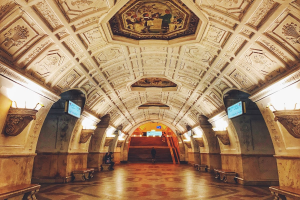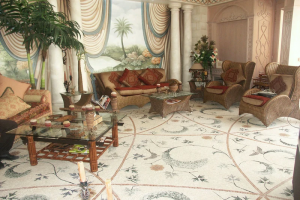The Lod Mosaic has had a rather dramatic life in recent years. It’s traveled around the world, visiting destinations like the Louvre in Paris, Fine Arts Museums of San Francisco and New York's Metropolitan Museum of Art, the Hermitage in St. Petersburg, as well as institutions in Italy and several other countries. Why the excitement? This extraordinarily well-preserved piece is not only large but has been described as “The biggest and most impressive and unique mosaic discovered in Israel”. Measuring in at 55 feet long and about 29 feet wide, is now at home in a new museum built on the site where it was found: The Shelby White and Leon Levy Lod Mosaic Archaeological Center in Lod, Israel.
Humble Beginnings
The story of the massive mosaic begins rather humbly. Back in 1996, The first section of the richly colorful mosaic was discovered accidentally during salvage excavations in 1996 under a central city square in Lod. A simple highway construction project quickly evolved into a rescue job for the Israel Antiquities Authority.
After carefully cataloging and stabilizing the site, the entire mosaic was reburied the same year. Layers of mesh and geotextile fabric preserved the mosaic until proper excavation could resume. Finally, in 2009, funding for the conservation of the mosaic and construction of an exhibition center came in the form of a donation from the Leon Levy Foundation and Shelby White, chairwoman of the Friends of the Israel Antiquities Authority.
The mosaic was uncovered and reassessed - and found to be in perfect condition. However, its new museum home had yet to be constructed. While plans and financing proceeded, the Lod Mosaic went on its Grand Tour. The piece was painstakingly disassembled, transported, and reassembled countless times - and served as a teaching tool for museum visitors around the world. Finally, in 2022, the Center was ready to welcome home its wayward traveler.
The Rolls Royce of Mosaic Art
“This is the Rolls Royce,” says archaeologist Hagit Torge from the Israel Antiquities Authority. “This is the most visually impressive mosaic we have found.” The craftsmanship and beauty of the Lod mosaic make it a masterpiece. Dating its installation to the third century AD was done by studying the debris covering the floors during its excavation - which contained pottery and coins of that period. So, how did this exceptional piece end up near a modern road near Tel Aviv? In 300 AD, Lod was a Roman colony, and the villa housing the mosaic floor was located in the wealthy part of the city. Lifestyle for these upper-class citizens dictated a certain degree of opulence, and it’s clear that the home was full of the highest-quality items. The section where the mosaic was found was likely a foyer for the mansion. The rule for entertaining guests was to dazzle and impress, and probably to intimidate. Over-the-top just didn’t exist!
An Array of Animal Art
So, who first commissioned the floor, and why is it filled with so many masterfully crafted animal figures? "The owner was probably a very rich merchant because he traveled throughout the world and he saw things, like all the ships and the fish on display in the mosaic," surmised IAA senior research archaeologist Torge.

Image source
CNN
The Lod Mosaic is, indeed, packed with aquatic life. There are many species of edible fish depicted in the design. Today, historians sea bream, mullet, sea bass, and snapper - as well as a barracuda.
The design of the mosaic seems to be influenced by North African mosaics of the same period. Interestingly, it doesn’t show any people. This suggests that it may have belonged to a Christian or a Jew who wanted to avoid the depiction of any Roman gods, said archaeologist Amir Gorzalczany from the Israel Antiquities Authority.
Animals such as the giraffe and rhinoceros are rarely depicted in ancient art, which makes their appearance in the octagonal medallion of the Lod Mosaic's central panel all the more remarkable. Within the areas of smaller squares and triangles depicting various birds, fish, and animals that surround a larger octagonal scene with ferocious wild animals, including a lion and lioness, an elephant, a giraffe, rhinoceros, tiger, and wild bull. Again, the detail is incredible - showing shadows of the animals, and even blood dripping from a bull in one panel depicting a hunting or fighting scene with a lion.
Details That Draw You In
“The mosaic is impressive, and the effort put into making the mosaic is very apparent,” comments Gorzalczany. “But beyond the mosaic itself, there is also the contact with the people who lived here and the simple laborers who worked here. It is very human.”
It’s not just about the beauty of the art - it’s also about the traces of the workers that were found under the mosaic floor’s foundation. After removing the mosaic, archaeologists found footprints and other timeless examples of mosaic craftsmanship. At one spot: the handprint of a fist where somebody placed their hand to steady himself as he worked. Also beautifully preserved: Examples of a colored sinopia – the mosaic model sculpted in fresh plaster used to lay out the design before the mosaic is made. Just like today at Mozaico, the artists used a design to carefully and precisely place the tiles in this complicated composition
The actual textures and layout of the individual tiles affected the look of mosaic floors. This was a hallmark of the Roman-era craftsmen. Shapes and scenes were created by the painstaking arrangement of small cubes or tesserae made of different colored stones, terracotta, or glass. “There is therefore an overall trompe l'oeil effect in creating naturalistic patterns from unpromising materials in a most unexpected way,” commented Christopher S. Lightfoot, Metropolitan Museum Curator of Greek and Roman Art.
A New Home

Image source
UPI
Visitors may now visit the Lod Mosaic - as well as additional mosaics from the same area of the original villa - at the newly opened Shelby White and Leon Levy Lod Mosaic Archaeological Center.
“Our dream for this city — itself a mosaic of cultures — is being realized today right before our eyes as we dedicate this most important museum, placing Lod on the world tourism map. We will enable people from around the country and the world to view this amazing treasure here in its original location, exactly where it was found,” said Lod Mayor Leon Revivo.

Image source
upi
"The mosaic was found here and should stay here after it flew around the world like a magic carpet,” said Shelby White at the opening. Visitors of the Center will be able to participate in guided tours and interactive exhibits in Arabic, English, and Hebrew. Archaeology lovers can learn more about the area, its rich history, and more at the Friends of Israel Antiquity Authority website.
Love the Look?
Mozaico has been inspired by the Lod Mosaic from the outset - and we have many handcrafted mosaic designs you might enjoy. Here are some ideas to kick off the search for a Roman-style masterpiece in your own home!
PREVIOUS POST
16 Unusual Ways to Install Mosaics
NEXT POST
The Webb Telescope Shows Us a Mosaic Universe
 Image source LodMosaic
Image source LodMosaic
 Image source LodMosaic
Image source LodMosaic
 Image source LodMosaic
Image source LodMosaic
 Image source LodMosaic
Image source LodMosaic
 Image Source Mozaico
Image Source Mozaico
 Image Source Mozaico
Image Source Mozaico
 Image source Daily Mail
Image source Daily Mail
 Image source CNN
Image source CNN
 Image Source Mozaico
Image Source Mozaico
 Image source Daily Mail
Image source Daily Mail
 Image source Daily Mail
Image source Daily Mail
 Image source MetMuseum
Image source MetMuseum
 Image source LodMosaic
Image source LodMosaic
 Image source LodMosaic
Image source LodMosaic
 Image source MetMuseum
Image source MetMuseum
 Image source UPI
Image source UPI
 Image source friendsofiaa
Image source friendsofiaa
 Image source upi
Image source upi
 Image Source Mozaico
Image Source Mozaico


2 comments
Thank you for your comment! Stay tuned for upcoming articles where we’ll dive into the rich history and exquisite details of other remarkable mosaics. If there’s a specific mosaic you’d like us to cover, feel free to let us know!
Can you post more blogs about other mosaics located there